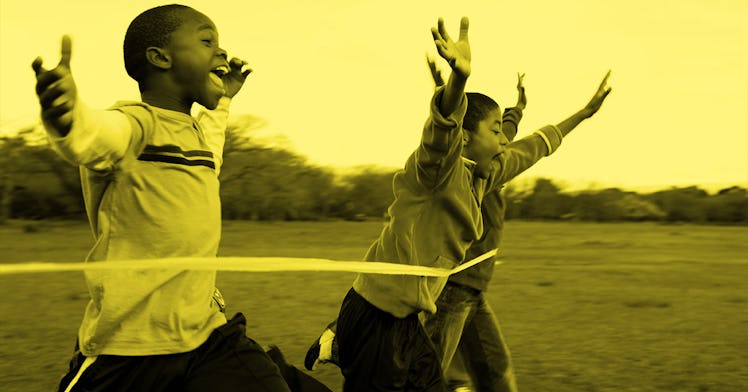6 Tips to Help Your Kid Dominate Any Foot Race, From An Olympic Coach
Teach 'em how to dust the competition.

What truer test is there for a kid than a foot race? There you are — maybe on the playground, maybe the blacktop — lined up against friends or one single rival, when — bam! — you set off towards the finish line hoping to best the others with your natural ability. For most kids, the strategy of a foot race begins and ends with “run as fast as you can.” But, of course, there is more to that. So much more.
That’s why we reached out to Bob Prichard. Prichard is the president of Somax Sports, a performance training institute dedicated to improving athletic efficiency. Since 1970, Prichard has trained runners, swimmers, and golfers, honing their abilities. Athletes he has trained have won an astounding 44 Olympic Gold Medals and set 11 World Records. So if you’re looking to offer your kid some advice on their running form, be it for an upcoming fun run, foot race to become ruler of the schoolyard, or because they just kind of look all wobbly when they sprint, Prichard shared six tips for honing their form so you can help your kid achieve their need for speed.
Lead With the Chin
As far as running form is considered, one of the easiest mistakes to fix is the position of the chin. Many people tend to run with their chin down but Prichard says if you look at the best distance runners, “they all lead with their chin.”. Why? Per Prichard, “this greatly reduces overstride and you can run faster because your center of mass is slightly more upright.” In other words? Where the chin leads, the body is more likely to follow properly.
Increase Stride Angle
Stride angle is the maximum opening between the front and back upper legs when you run. It usually occurs during “toe off”, aka when your toes press off the ground. By observing Usain Bolt’s legendary starts, Prichard’s team at Somax discovered that for every degree a runner increases in stride angle, the length of your stride will increase two percent. Explaining to your kids to try to bring their front knee up higher as they run could help them turn on the jets.
Teach Them To Run With Their Knees and Elbows
Many runners try to increase stride length in hopes that it will help them reach their top speed, but Prichard says this is a common mistake and leads to overstriding. “Overstriding is reaching out with the lower leg to try and lengthen your stride,” says Prichard. So how do you make sure your kid is increasing their stride angle without overstriding? Prichard says he teaches kids to “run with your knees and elbows instead of your feet and hands.”
Cut Down on Toe Lift
According to Prichard, this one of the most common mistakes runners make when trying to increase speed. “People will lift their toes when they are running and end up landing on their heels,” he says. It can lead to shin splints, because landing on the heel and move forward while the shin muscles are still contracted, causing tears in the muscles.
Stretch Your Shoulders
The shoulders are an essential but often overlooked part of a runner’s stretch. Why? Upper body torque or twisting the upper body while running puts runners at a huge disadvantage. That movement, per Prichard, is “mainly caused by stiffness in the shoulders.” Stretching your shoulders not only helps one move faster but also avoid injury.
Pay Mind To Chest and Stomach Flexibility
Runners run on oxygen. So taking in more oxygen is a key aspect of being able to dust opponents. Per Prichard, your oxygen intake while running “is mainly determined by how much flexibility you have in your chest and stomach.” What are some of the leading cause of tightness in these areas? According to Prichard, this stiffness often comes from bench press and sit ups. These exercises cause muscles become tight and “reduce the amount of air you can take in.” We doubt your kids are tossing steel, this is a good thing to know as they graduate from schoolyard races to track and field, football, or, well, any sport.
This article was originally published on